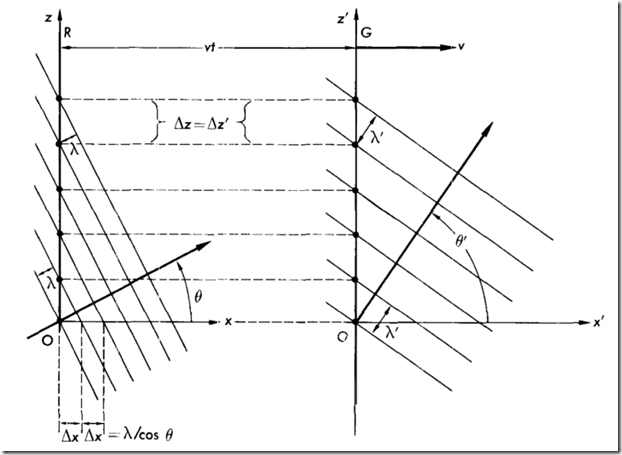Watching a Television broadcast from Earth while moving Relativistically
Imagine you are in a spaceship moving away from the earth at a velocity v. Imagine that a TV broadcast is sent to your spaceship from Earth. How would you see the broadcast?
The Approach to the solution
We imagine that observers G and R are situated at their respective origins, measure the frequency of a light wave with plane wave fronts by counting the number of fronts which pass their origins in some specified time interval. Let the observed directions of propagation be denoted by angles ![]() (in G) and
(in G) and ![]() (in R), with respect to the positive x’ (in G), x (in R) axes. The situation is diagrammed below:
(in R), with respect to the positive x’ (in G), x (in R) axes. The situation is diagrammed below:
They will count a different number of wavefronts
Suppose that starting at the instant t = t’ = 0 when the origins coincide, G counts wove fronts for 0 time t’, and that their observed frequency is v’; the number of fronts which he counts is then t’v’. Similarly, beginning at the some instant, let R. count wovefronts passing 0: he will obtain iv. But ![]() is not equal to t v, since there are fronts between the two origins which, in the Figure above, have been counted by R, but not by G. The number of these fronts lying between 0 and 0’ may be found by dividing the distance between origins, vt, by the horizontal distance
is not equal to t v, since there are fronts between the two origins which, in the Figure above, have been counted by R, but not by G. The number of these fronts lying between 0 and 0’ may be found by dividing the distance between origins, vt, by the horizontal distance ![]() between fronts. From the picture,
between fronts. From the picture, ![]() = X/cos 0 = C/Y cos 0, so the additionol number of fronts measured by R is vt/
= X/cos 0 = C/Y cos 0, so the additionol number of fronts measured by R is vt/![]() =
= ![]() .
.
Therefore, the relation between ![]()
If we use the time dilation formula (time passes slower for G than it does for R)
![]()
we get:
![]()
Summary
Of course, a simpler solution would be to use digital video recorders – and buffer the frames as they are received. Then, just play them back at 30 frames per second from the recorded buffer. This would leave the original broadcast frequency at 30 frames per second.
Leave a Reply